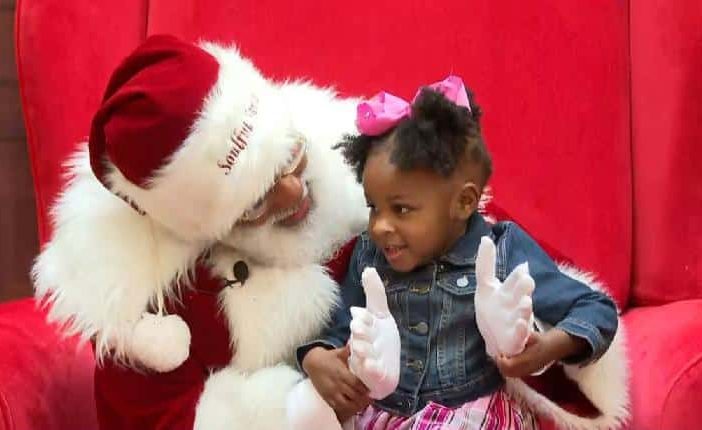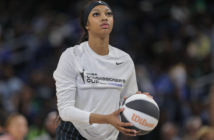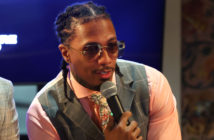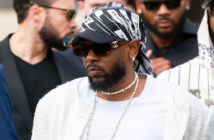*(CNN) — When I spotted a pair of Black Santa pajamas on Carter’s children’s store website last month, I immediately purchased them for my one-year-old daughter. I was excited for two reasons: one being my personal obsession with Black Santas because I rarely saw them growing up in Michigan, and two being that I want my daughter to see herself represented in the most precious traditions of Christmas— our family’s favorite holiday.
As I continue my search for Black Santa dolls, pajamas, ornaments and even a Black, jolly St. Nick at my local mall every year, I know I’m not the only one on the hunt. Santa employment agencies tell CNN there is an increased interest in diverse Santas from Black Santas with Black Mrs. Clauses to LGBTQ, deaf and Spanish-speaking Santas. And the demand for inclusion during the holiday season isn’t just limited to Santa. The popular Elf on the Shelf dolls that parents place around their homes to monitor naughty or nice behavior come in different skin tones. And a global non-profit recently launched an original Black nativity set that includes baby Jesus, Mary and Joseph. Most depictions of Jesus have historically been White. The diversity should come as no surprise given the country’s demographics are changing (Black and brown people are set to make up the majority of the population by 2050) and there is a push for policies that embrace same-sex and interracial families.
Quite frankly, a non-traditional Santa Claus or elf brings even more joy to the season with children of all races waiting for Santa to grace their chimneys and front door steps the night before Christmas.
That joy is playing out at malls, Christmas parties, churches and parades.
OTHER NEWS ON EURWEB: Abducted 5-Month-old Twin Baby Boy (Kason Thomass) was Found in Car After 2 Days | WATCH
On a recent morning at the Gallery at South Dekalb in Decatur, Georgia, several Black families had a chance to meet with a joyful Black Santa in the middle of the mall.
Most of the parents who spoke to CNN had a similar experience as me growing up. They only saw White Santas. So, they were pleased that their children or grandchildren could give their Christmas list to a Black Santa.
“The fact that there is a Black Santa here, I was so excited,” said Jackie Walker, who was with her 8-month-old granddaughter. “It represents us African Americans. Here we are a diverse nation we live in, everybody wants to see somebody that’s important that looks like them.”
Shameka Parker said she has made it a family tradition to take her daughters to meet Black Santas over the years.
And in Atlanta, which is considered the Black mecca, Black Santas are common. (I took my dog to a Christmas event at an Atlanta area Petsmart in 2019 and Santa was Black!)
“It’s important for us to see ones that look like us,” Parker said. “It’s amazing that we get to see a representation of ourselves and that’s what it’s all about.”
Black Santa and little black girl – CNN screenshot
Black Santas are rare — but that’s changing
Black Santas themselves are hoping their presence can make a difference.
Chris Kennedy said he decided to become a professional Santa after someone mailed him a racist letter in 2020 demanding that he remove the inflatable Black Santa from his yard. The letter stated that Santa was a White man and that Kennedy’s decorations were deceiving.
Kennedy said he forgave the anonymous person who wrote the letter but later purchased an even larger Black Santa for his yard and now plays Santa at community events. Black Santas, he said, are rare and children of color deserve to see a Santa who looks like them.
“I personally think Black and brown kids should be able to see themselves represented in Santa and Mrs. Clause,” said Kennedy who was featured in the HBO documentary Santa Camp. “There’s nothing wrong with diversity.”
In fact, there are long-term psychological benefits to representation.
Research shows that when children are exposed to characters who look like them in books, television shows and other outlets, it boosts theirs self-esteem and self-worth.
Dr. Shawn Utsey, a psychology professor at Virginia Commonwealth University who focuses on the African-American experience, said if society is working to become more inclusive, diversity in Christmas traditions should be welcomed.
“It does young children well to see themselves and people like them represented in Santa Claus,” Utsey said. “I think it reinforces racial socialization and that there are positive aspects to being Black.”
That same push for diversity also applies to the church. After all, Christmas commemorates the birth of Jesus Christ.
The global non-profit The World is for Everyone launched an original Black nativity scene this month with hand-painted, polyresin baby Jesus, Mary and Joseph figures. The retail price for the set is $65, but the organization is currently offering it at a discounted rate as it tries to meet a 500 pre-order minimum by the manufacturer.
Niels van Deuren, co-founder of The World is for Everyone, said he decided to launch the set after attending a Black church in Brooklyn, New York, and observing only White figures of Jesus. van Deuren said Christianity is now a global religion and images of Jesus should not be limited to a blue-eyed White man.
“For children to see only a White man doing good things and they can’t identify with that…. it feels like that’s not good,” van Deuren said.
Irma Barros, also co-founder of The World is for Everyone, agreed. Barros said a child’s perception of the world is often shaped by the heroes and role models they see in the media. In the Christian religion, Jesus is considered a savior.
“If Christianity is in Asia, we can have an Asian Jesus too,” Barros said. “In this age we have to stop thinking that only a White man can connect with us and portraying the values of redemption and Christianity. ”
The-CNN-Wire
™ & © 2022 Cable News Network, Inc., a Warner Bros. Discovery Company. All rights reserved.
We Publish News 24/7. Don’t Miss A Story. Click HERE to SUBSCRIBE to Our Newsletter Now!



